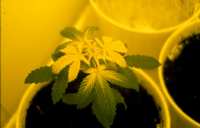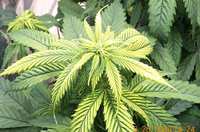|
Added by: snoofer edited by: faqness
Contributed by: Mr. HIGHway
These photographs were taken from Cannabis World through an exhaustive search of the Archives. I would like the take the time to thank every member at Cannabis World for their contributions who made this all possible. I hope it helps as many people as possible.
I will start with the mobile elements, or the ?Main nutrients? of Nitrogen, Potassium, and Phosphorous. Next will be Magnesium, Sulphur, Calcium, and Iron. Next is what we call the ?Trace Elements? of Molybdenum, Copper, Zinc, Boron, and Manganese. These are the 12 elements that Cannabis needs to survive, in order of importance.
The ?Trace Elements? are only needed in very small quantities; if they are present in large quantities, they can lockout other elements - which mask as other problems! Some will even fool you by masking as Over fertilization, or another deficiency.
Mobile Nutrients
Nitrogen
Nitrogen is a key Element in the production of Amino Acids, which are the building block of Proteins. Many plant hormones contain Nitrogen as well as Chlorophyll, DNA and RNA (Genetic materials), and a myriad of enzymes that help control and regulate growth. Nitrogen is the most mobile element. growth. Nitrogen is the most mobile element.
Plants suffering from this deficiency are distinct in their pattern of yellowing. Yellowing starts on the older leaves and progresses upward, leaving the top parts of the plant green.
Notice that the large fan leaves are yellowing and turning purple-ish. from the bottom up.
Feeding with a high N fert will clear it up, like an emulsion of fish at 5-1-1.
[Editor?s note: Leaves will turn pale green, then yellow evenly. There are no intervenial striping or yellow patches. Color is uniform over the entire leaf. Yellowing is expected during flushing, as the plant is using up all available internal nutrients]
 Phosphorous Phosphorous
Phosphorous is used for plant energy by being assimilated into molecules called Adenosine-tri-phosphate, or ATP. This molecule is necessary for any plant activity that requires energy such as root growth, flowering, respiration, and vegetative growth.
 Phosphorous deficiencies are distinct. Purple stems, leaf stems, leaf veins and stunted growth are a sure sign of a Phosphorous deficiency. Leaves will also tend to be smaller and dark green, and may or may not include necrotic patches. Bud size will be smaller and underdeveloped, as will the root mass. Phosphorous deficiencies are distinct. Purple stems, leaf stems, leaf veins and stunted growth are a sure sign of a Phosphorous deficiency. Leaves will also tend to be smaller and dark green, and may or may not include necrotic patches. Bud size will be smaller and underdeveloped, as will the root mass.
A good all-around fertilizer like Peter's 20-20-20 will clear this up.
Potassium
 Potassium serves to aid in the process of photosynthesis, nutrient uptake, respiration, and is a key to sturdy stems and disease resistance. Having an adequate supply for the plant early in it?s life stage will keep your seedlings from falling over. Potassium serves to aid in the process of photosynthesis, nutrient uptake, respiration, and is a key to sturdy stems and disease resistance. Having an adequate supply for the plant early in it?s life stage will keep your seedlings from falling over.
Potassium deficiencies are identified by necrosis on the margins of larger fan leaves. Necrotic patches can be seen on the leaves as well. Leaves will eventually turn yellow, brown and die off. Most of the plants that show signs of a Potassium deficiency are going to be the tallest and best looking plants you have.
Again, feeding with a good all-around fertilizer will clear it up as well.
You can also use wood ashes and water them into your soil to fix this. You'll need to replace your soil's holding capacity of Potassium, and have a surplus before it will become available to the roots again.
Minor Nutrients
Chances of seeing anything but an Iron deficiency are slim, but when pushing the envelope with HID?s and CO2 enrichment, they will pop up from time to time. Most are seen, if ever, in outdoor grows.
 Magnesium Magnesium
Chlorophyll has the same structure as Hemoglobin, except that it has a magnesium atom in place of the Iron atom. Chlorophyll is how plants make sugars to feed the process of building ATP through the Krebs cycle.
 A magnesium deficient plant is identified by intervenial chlorosis, necrosis, and eventually a lockout of plant nutrients. The problems starts at the bottom of the plants and works it?s way up. A magnesium deficient plant is identified by intervenial chlorosis, necrosis, and eventually a lockout of plant nutrients. The problems starts at the bottom of the plants and works it?s way up.
 These images depict different stages and signs of a magnesium deficiency. The first picture is a Mg deficient plant in flower, and the second two are of the leaves to show what I mean by Intervenial Chlorosis. These images depict different stages and signs of a magnesium deficiency. The first picture is a Mg deficient plant in flower, and the second two are of the leaves to show what I mean by Intervenial Chlorosis.
Treating with an Epsom salts mix will clear this right up.
 Sulphur Sulphur
Sulphur is an important element in the structures of amino acids and proteins, and is needed for normal plant respiration and metabolism of sugars and other compounds.
If you ever see this in your plants, then you can be assured that you have this deficiency. Look for yellowing starting from the top, and progressing down, including the veins of the leaves. Treat the same as a Mg deficiency.
 Calcium Calcium
Calcium is an important co-enzyme in the production of fatty acids, cell membranes, and is necessary for normal mitosis/cell division. A Ca deficiency will stunt plant growth. Acidic soils may increase the risk of a Ca def.
Trace Elements
The six trace elements of Boron, Copper, Iron, Manganese, Molybdenum, and Zinc are not required in large quantities, but are important in the transfer of energy in plant processes.
 Boron Boron
This is a rare occurrence and is exemplified by small gray or necrotic patches on the growing shoots which eventually die.
Fixing this is done easily by applying a foliar spray of eyewash containing Boric Acid. This picture is not really the best IMO, but it shows a gray patch on a leaf that is indicative of what to look for. This will most likely occur in outdoor grows.
 Copper Copper
A copper deficiency is commonly mistaken for an over fertilization problem, but it is set apart by the growing tips dieing off first along with the crispy leaves. The new shoots will die from the tips and margins first, often going brown or even white before they die.
A foliar feeding with a commercial fungicide containing Copper (ie. Copper Sulphate) will clear it up, but the damaged leaves may never recover.
 Iron Iron
An Iron deficiency will mask a Magnesium deficiency. If you look at the newer growth, that will be where the plant exhibits the intervenial chlorosis typically differentiating it from a Magnesium deficiency.
 Notice how the top of the plant is exhibiting intervenial chlorosis and the lower part is unaffected. Notice how the top of the plant is exhibiting intervenial chlorosis and the lower part is unaffected.
 Manganese Manganese
A Manganese deficiency exhibits a general chlorosis, followed by yellowing patches and necrotic patches between the veins of the larger fan leaves.
 Molybdenum Molybdenum
A Molybdenum deficient plant will exhibit yellowing necrotic leaves from the tips inward, with necrotic lesions present from the tips inward. A very distinctive feature is that it occurs in the middle of the plant. It also may spread to the rest of the plant if not stopped, eventually killing your plant.
Fritted Trace Elements may be added to your soil mix as you prepare it for planting. A good Hydroponic nutrient should contain ample micros to get your plant through its lifecycle.
 Zinc Zinc
A Zinc deficient plant is obvious from the wispy new growth with twisted leaflets at 90°. There is also intervenial chlorosis at the top of the plant that is commonly confused with an Iron deficiency.
Notice in this picture that the older grown leaves are relatively unaffected and healthy
Other persistent problems
 pH pH
Improper pH can cause an abundance of problems that you might easily confuse with other problems or deficiencies.
A pH imbalance may also be the cause of the deficiencies in the first place. pH in soil is best in the range of 6 up to 7.5, and in a Hydroponic system it?s best at 5.2-5.8.

 Over Fertilization Over Fertilization
This is a very common problem that can be disguised as an improper pH, or light burning, as well as a myriad of other problems.
The first picture masks as over Nitrification, but notice how the entire leaf is curled under, not just the tip.
 This photo displays many problems associated with overferting, some of which could be a simple imbalance of pH and a certain nutrient/micro lockout at the given pH. This photo displays many problems associated with overferting, some of which could be a simple imbalance of pH and a certain nutrient/micro lockout at the given pH.
Over watering/ lack of Dissolved Oxygen
 Droopy leaves and lower leaf yellowing are indications of persistent over watering problems. Droopy leaves and lower leaf yellowing are indications of persistent over watering problems.

 Over Nitrification Over Nitrification
The following pictures show the ?claw?: indicative of over Nitrification. Some growers loadup their plants with Nitrogen prior to flowering. This will prepare them for the stretch to follow, and will increase bud production if induced a few weeks prior to blooming the plant.
 Radiant Heat Radiant Heat
[Editor's note: Radiant heat is also called ?light burn?. Typically, topmost leaves will become pale green, then turn brown as the burn progresses. Plants on the outmost edge of the garden will remain a healthy dark green, with light burned plants directly underneath the reflectors in a circular pattern.]
|